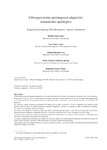Fibroqueratoma periungueal adquirido: tratamiento quirúrgico

Use este enlace para citar
http://hdl.handle.net/2183/29954Colecciones
- Investigación (FEP) [507]
Metadatos
Mostrar el registro completo del ítemTítulo
Fibroqueratoma periungueal adquirido: tratamiento quirúrgicoTítulo(s) alternativo(s)
Acquired periungual fibrokeratoma: surgery treatmentAutor(es)
Fecha
2007Cita bibliográfica
López López, D., López López, L., Barriuso Cao, M., Álvarez-calderón Iglesias, & Fornos Vieitez, B. (2007). Fibroqueratoma periungueal adquirido: tratamiento quirúrgico. Revista Internacional de Ciencias Podológicas, 1(2), 47 - 53. Recuperado 10 de marzo de 2022, de https://revistas.ucm.es/index.php/RICP/article/view/RICP0707220047A
Resumen
[Resumen] El fibroqueratoma periungueal adquirido es un tumor fibroepitelial benigno, relativamente frecuente pero con escasa inci-dencia a nivel del pie, que se caracteriza por presentar una masa carnosa cubierta de piel, de la dermis hiperpigmentaday con hiperqueratosis en su porción distal, de consistencia firme e indurada, con un tamaño variable, de 3 a 15 mm. dediámetro. En ocasiones, puede existir un crecimiento del tumor que no suele exceder de 1,5 cm. de diámetro. Así mismo, puedeaparecer dolor después de traumas mínimos o producir sangrado y entonces es cuando se indica el tratamiento quirúrgi-co, como es el caso que vamos a presentar.Se trata de una mujer de 31 años de edad, que acude a consulta por presentar, a nivel del tercer dedo del pie derecho,fibroqueratoma periungueal adquirido doloroso,a nivel del canal tibial, de 0,5 cm. de ancho por 0,6 de largo.La paciente no reseña,antecedentes personales ni familiares significativos. Se realiza estudio analítico y radiológico paradescartar existencia de patología ósea subyacente.La técnica empleada ha consistido en realizar una incisión elíptica,de forma paralela siguiendo las líneas de tensión dela piel,para proceder a biopsiar el fibroqueratoma y remitirlo a anatomía patológica. El postoperatorio ha resultado indoloro y el aspecto del dedo óptimo, sin existir recidivas del fibroqueratoma periunguealadquirido,después de un año [Abstract] Acquired periungual fibrokeratoma is a benign fibroepitelial tumor, relatively common, but with minor incidence at the foot. It is characterized by presenting a fleshy mass covered with hyperpigmented skin and with hyperqueratosis in its distalportion, whose consistence is strong and "indurada" with a size that varies from 5 to 10 mm in length.Sometimes it can be painful after minor trauma or it can even bleed. In that case, surgical treatment can be suggested, asin the case reported.We present the case of a 31 years old patient, who comes to the office due to a painful isolated periungeal fibroma at thelevel of the third right toe, being recommended the surgical excision of the mass.Blood analysis and dorsolateral and dorsoplantar x-rays are required, to make sure that there ́s no evidence of underlyingbony pathology. The surgical technique has been carried out, under local anaesthesia making an elliptical incision following the lines oftension of the skin, and removing the fibroma. Sutures were necessary to heal the wound. After removing the mass, abiopsy was carried out and sent to the pathological anatomy department to ensure the diagnosis. The postoperative period was painless and the appearance of the toe was excellent. After one year follow-up, nor recu-rrences or associated problems appeared.We conclude that acquired periungual fibrokeratoma represents a well defined clinically and histologically benign tumor,easily diagnosed. The surgical approach appears to be as the best way to manage the situation definitively.
Palabras clave
Fibroma periungueal
Fibroqueratoma periungueal adquirido
Fibroqueratoma digital adquirido
Tumor fibroepitelial
Enfermedad de Pringle-Bourneville
Esclerosis tuberosa
Fibroqueratoma hereditario
Tumor de Koënen
Periungual fibroma
Acquired periungual fibrokeratoma
Acquired digital fibrokeratomar
Koënen tumor
Hereditary fibroqueratoma
Tuberous sclerosis
Pringle-Bourneville disease
Fibroepitelial tumor
Fibroqueratoma periungueal adquirido
Fibroqueratoma digital adquirido
Tumor fibroepitelial
Enfermedad de Pringle-Bourneville
Esclerosis tuberosa
Fibroqueratoma hereditario
Tumor de Koënen
Periungual fibroma
Acquired periungual fibrokeratoma
Acquired digital fibrokeratomar
Koënen tumor
Hereditary fibroqueratoma
Tuberous sclerosis
Pringle-Bourneville disease
Fibroepitelial tumor
Versión del editor
Derechos
Atribución 3.0 España
ISSN
1887-7249
Ítems relacionados
Mostrando ítems relacionados por Título, autor o materia.
-
Fibromixoma superficial acral: a propósito de un caso
Rodríguez Casal, Candela (2023)[Resumen] Presentación del caso: Se presenta el caso de una mujer de 49 años de edad, que fue derivada del Servicio de Cirugía General del Complejo Hospitalario Universitario de Ferrol (CHUF) a la Clínica Universitaria ... -
Fibroqueratoma periungueal adquirido en la edad pediátrica, a propósito de un caso
Corominas, Laura; Fernández-Ansorena, Ana; Saus, Carlos (Universidade da Coruña, 2019)[Resumen] Objetivo: El fibroqueratoma periungueal adquirido es un tumor fibroepitelial benigno, con escasa incidencia a nivel del pie. Es una tumoración cubierta de piel hiperpigmentada con hiperqueratosis en su porción ...






